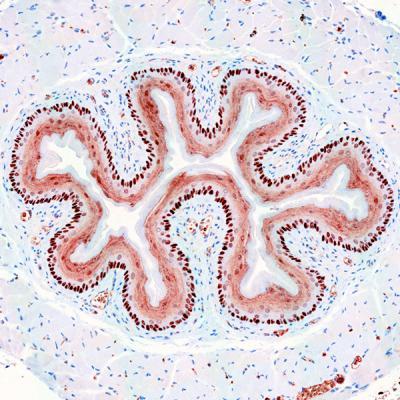New research has discovered that NANOG, an essential gene for embryonic stem cells, also regulates cell division in stratified epithelia, which form part of the epidermis of the skin or cover the oesophagus or the vagina in developed organisms. This factor could also play a role in the formation of tumors derived from stratified epithelia of the oesophagus and skin.
Pluripotency factor NANOG is active during just two days before implantation of the embryo in the uterus, from day 5 to day 7 post-fertilization. At this critical period of development, NANOG contributes to giving embryonic stem cells the extraordinary capacity to make up all of the tissues that become the adult organism, an ability known as pluripotency.
Up until now, it was thought that the function of NANOG was limited to the developmental stage immediately prior to implantation but the new work led by Manuel Serrano and Daniela Piazzolla of the Spanish National Cancer Research Centre (CNIO) shows that NANOG also plays a role in adult stem cells.
After analyzing the presence of NANOG in different mouse tissues by immunohistochemistry, the team found that, in addition to being present in embryonic tissue, this factor is also found in stratified epithelia such as the oesophagus, skin or vagina.

A cross section of a mouse esophagus. The dark brown staining shows epithelial cells containing NANOG protein. Credit: CNIO
NANOG Is Linked to Tumors Derived From Stratified Epithelia
The researchers studied a line of mice that can be programmed to induce the NANOG factor over a limited period of time. When NANOG was increased in these mice, the epithelia showed an increase in cellular proliferation, hyperplasia, and an increase in the amount of DNA damage in the cells.
"Interestingly, the effects of NANOG were only observed in stratified epithelia, whereas other tissues, such as the liver of kidney, were completely indifferent to the expression of NANOG," says Serrano. This reinforces the idea that NANOG selectively operates in stratified epithelia. "Using genome-wide analysis, we demonstrate that this factor is able to specifically regulate cell proliferation in these tissues, and it does it by means of the AURKA protein that is involved in the control of cell division."
The authors found that NANOG is increased in patient-derived tumor samples from stratified epithelia. When they blocked the action of the gene using RNA interference, the cell proliferation index was reduced.
"This tells us that these cancerous cells depend on NANOG activity to maintain their high proliferation rate and oncological properties," says Serrano.
Source: Centro Nacional de Investigaciones Oncologicas (CNIO)





Comments